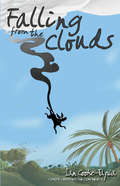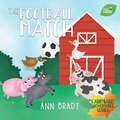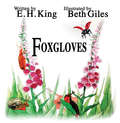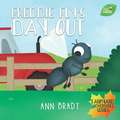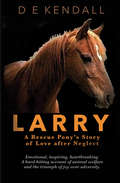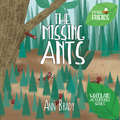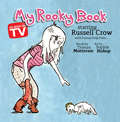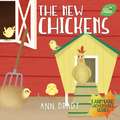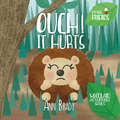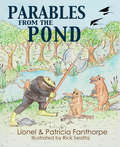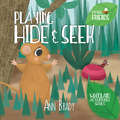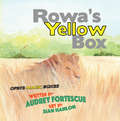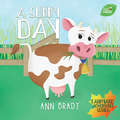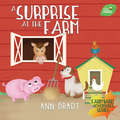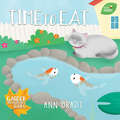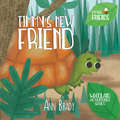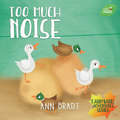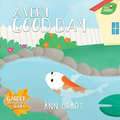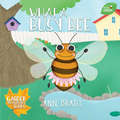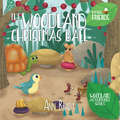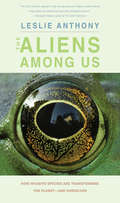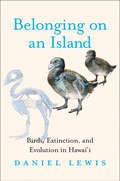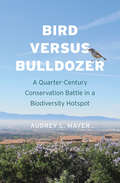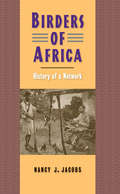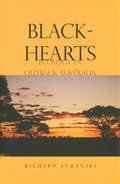- Table View
- List View
Falling from the Clouds: How Coyote Realised His World Was Smaller Than He Thought (Coyote Crosses the Continent #1)
by Ian Cooke-TapiaCoyote knows everything there is to know about his homeland. From the sea to the east,to the ocean to the west; it is all known to him. He knows the desert and the plains and the spires. Coyote knows too how to get any creature and the land itself do what he wants and believe it is their idea. One day, as Coyote walks the clouds in search of food, he notices a creature he had never seen before. Meeting Khirkinchu, the Giant Armadillo, makes Coyote realise that the world he thinks he knows is small indeed. And that just can’t do! He is Coyote, and he should know everything there is to know about the world. Full of curiosity and energy Coyote sets out in search of the southern lands. Yet Kirkinchu warns him that he will never reach them unless he meets the King of the Vultures.
The Football Match (Little Friends: Farmyard Adventures Series #6)
by Ann BradyThe farmer and his family have gone out for the day so the Little Friends are having a football match. Rover Dog is one of the referees and Hilary Horse and Betty Cow are the team captains. Find out which team Penny Pig, Georgie Goat, the chickens and ducks are on, and what their team names are. Which team will win the game?
Foxgloves (Meadow Flowers Series #1)
by E. H. KingFoxgloves tells the story of how the flowers got their name. A naughty red fox keeps stealing chickens from a nearby farm, the farmer and his wife must devise a plan to stop the fox from stealing their chickens. A tale for all of the family, full of farms, foxes and fun. Beautifully illustrated - can you find the foxgloves on every page?
Freddie Fly's Day Out (Little Friends: Farmyard Adventures Series #2)
by Ann BradyFreddie is fed up because his brothers don’t want to play games. So, he goes on an adventure across the fields where he meets Clara Cow. Clara is a special cow who has come from another country. She tells Freddie all about herself and her sisters, and why she makes a tinkling noise when she walks.
Larry: A Rescue Pony's Story of Love After Neglect (Wordcatcher Real Life Stories and Biographies)
by D. E. KendallBased on real events. Larry's story is one of hope and love after cruelty and oppression. A stark view of the dark side of our modern equestrian world, interlaced with humour and reflection. Through the telling of his story from Larry's perspective, you're hard-pressed not to fall in love with his cheeky character and resilience! Suited to animal-lovers with or without equine knowledge, this story really makes the reader think, but the love and kindness shown in this book shines through! Through her research and brilliant use of description and dialogue, D E Kendall tugs at your heart, and then lifts you with humour and compassion. If you have never owned a horse, it will give you an insight into horse ownership. And if you already own a horse, you will relate to the tale and recognise many of the situations Larry had to endure.
The Missing Ants (Little Friends: Woodland Adventures Series #2)
by Ann BradyFlora Frog is sat enjoying the sunshine when she hears that Abby Ant’s sister Annie Ant and her brothers Alex and Andy Ant are missing. Bella Bee and Dolly Dragonfly go off to try to find them but they can’t. Poor Abby Ant becomes upset so Boris Wasp tries to find them. Soon he comes back with good news and before long the missing Ants come sailing down the river. This makes everyone very happy and Abby Ant goes sailing away into the sunshine.
My Rooky Book (Starring Russell Crow)
by Tristan Motteram Sophie BishopRussell was originally thought to be a crow (and that’s how he was given his name!). But, even though Russell’s a rook, he liked the name so much - and Russell Crow stuck! He’s a mischievous bird. He poops on the floor. He steals food. He hides shiny things. But to Russell, she is his Miss Helen. To Helen, he is her Roo. They are family.
The New Chickens (Little Friends: Farmyard Adventures Series #3)
by Ann BradyMummy Hen and Daddy Rooster have got some new baby chickens but they don’t know what to call them. She asks the Little Friends, Penny Pig, Hilary Horse, Rover Dog, Tulip Sheep and Freddie Fly for some names. Read the story, look at the chicks, and guess what name Mummy Hen chose to call each baby chick.
Ouch! It Hurts (Little Friends: Woodland Adventures Series #4)
by Ann BradyBobo the Baby Rabbit is running around outside with his brothers and sisters. When he gets tired he goes to sit down and sits on top of Emily Hedgehog who quickly rolls into a ball, frightening poor Bobo and pricking him with her spikes. Bobo doesn’t know about Emily Hedgehogs spikes, do you? Emily tells him why she has them and how they protect her. Once Bobo knows that Emily didn’t mean to hurt him he and Emily become good friends.
Parables from the Pond: The Story of Hugh John Green and The Webguard
by Lionel FanthorpeThe Kingdom of Frogdom is part of a strange parallel universe, where the frogs think and act like we do. Their leader is a fearless warrior-priest: the Reverend Doctor Hugh John Green. The rats are the evil villains in this universe, and when they attack innocent, harmless little creatures, Hugh John and his great bullfrog army – the Webguard – come to the rescue. As well as being a powerful warrior Hugh is a dedicated teacher, and he tells the other frogs parables that have profound and important meanings. “Parables from the Pond” combines vivid blow-by-blow accounts of battles between the rats and the Webguard with the deeply meaningful stories that Hugh tells.
Playing Hide and Seek (Little Friends: Woodland Adventures Series #3)
by Ann BradyDora Dormouse is on her way to have tea with Timmy Tortoise when she comes across Alex Ant who is playing hide and seek. Alex Ant asks for Dora Dormouse’s help as he needs to count to ten so he can go to find the hidden ants. Dora tries to help but is finding it hard so she asks for help from Sammy Spider. But even with Sammy Spider’s help they still can’t count to ten. Only when Godfrey Grasshopper comes along and tells them what to do can they manage to count to the right number. Once they have Alex Ant can go and look for the hidden ants. Can you help Alex Ant count the right numbers and find the hidden ants?
Rowa's Yellow Box (Opin's Magic Boxes #3)
by Audrey FortescueRowa’s Yellow Box is the third in the series of beautifully illustrated books for 3 to 6 year old children. They are family oriented stories where the children have coloured boxes to play with. But, occasionally there is something inside a box which takes the child, and other family members, on an exciting magical adventure. In this third book, Rowa is playing with her cousins Opin and Flikity when she opens a yellow box. Inside she finds bananas and a cake which take them on a magical safari adventure. They see many animals, big and small, cuddly and scary, but where did the bananas go? They return home to share the cake and snuggle up in sleeping bags to dream of their favourite animals. The books are based on the author's own family and their experiences. They make a good bedtime stories as at the end of each book the children go to bed and say “night-night”. The stories are also valuable as early readers as they incorporate many of the first words which children learn to read.
A Sunny Day (Little Friends: Farmyard Adventures Series #1)
by Ann BradyClara Cow is sat sunbathing when she sees Barry Badger passing by. He is going to visit his friend. Not long after, Jenny Wren and Abby, Annie, Alex and Andy Ant all come looking for Barry. Find out if they find him, who Barry has gone to visit, and why.
A Surprise at the Farm (Little Friends: Farmyard Adventures Series #4)
by Ann BradyOne day a pile of wood is left at the farm for the farmer to build a new pen. When he leaves for market the Little Friends - Penny Pig, Hilary Horse, the ducks, Rover Dog and Freddie Fly - all try to guess what the farmer will bring back to put in the pen. How surprised they are when he returns to discover some new Little Friends have joined the happy band at the farm? Can you guess who he might have brought home?
Time To Eat (Little Friends: Garden Adventures Series #1)
by Ann BradyKitty Cat and Marty Mole are surprised by the sound of a big splash. Kitty Cat tells Marty that Karla Koi is feeling hungry and is jumping for flies. Karla Koi thinks the lady from the big house has forgotten to feed them. When Bella Bee flies into the garden she says she will help Karla by going to look for the lady. After flying to the big house, Bella Bee finds the lady is coming to feed the fish. Hiding in the rose bush, Bella watches as the fish gobble the fish food. After the lady leaves she goes to see if Karla Koi is still hungry. Do you think she is?
Timmy's New Friend (Little Friends: Woodland Adventures Series #5)
by Ann BradyTimmy Tortoise is a sad and lonely tortoise because he hasn’t got a friend. Dora Dormouse tries to help Timmy by asking who he has asked to be his friend. Timmy tells Dora about Sammy Spider, Fred Fox, Sarah Butterfly and The Ants. Timmy Tortoise thinks they are all special animals so they can’t be his friend. Dora Dormouse knows Timmy is right about them all being special but then she has a brilliant idea as to who can be Timmy Tortoises’ friend. Can you guess who it is?
Too Much Noise (Little Friends: Farmyard Adventures Series #5)
by Ann BradyThe ducks have come up from the pond and are trying to have a race around the farmyard. But Hilary Horse, Penny Pig, and Betty Cow think they are making too much noise. The ducks are sad because they don’t know what to do. Then Rover Dog has a good idea and tells the ducks where they can go to run around. Do you think you can help them?
A Very Good Day (Little Friends: Garden Adventures Series #3)
by Ann BradyWinter is over and the garden is coming to life once more. The Little Friends are starting to visit and Big Fish is feeling very hungry. Kitty Cat calls to say hello, telling Big Fish how sorry she is he can’t go with her to visit the Little Friends in the farmyard. Not long after, Bella Bee calls to say hello to Big Fish. Bella tells Big Fish about collecting nectar and how she makes honey from it. She also tells him what happens to the honey once it is ready and about the lady from the big house collecting the honeycomb. Big Fish thinks Bella Bee is very clever.
What a Busy Bee (Little Friends: Garden Adventures Series #2)
by Ann BradyOne sunny day Bella Bee flies into the garden. Jenny Wren hears her buzzing and comes out of the bird box to find out what Bella is doing. Bella tells Jenny she is going to make honey. Bella and the other bees in the bee hive are very good at making honey. But to do this they have to collect lots of nectar. There are lots of different flowers growing around the garden and Bella Bee must decide which ones to collect pollen from. Once filled up with nectar, Bella Bee falls asleep but is woken up by Kitty Cat before the rain starts.
The Woodland Christmas Ball (Little Friends: Woodland Adventures Series #6)
by Ann BradyIt’s winter time and all the Little Friends are getting ready to go to sleep. But first they are going to have a big party. Flora Frog gets everyone to tidy the clearing. Bella Bee polishes the mushrooms and Bennie Bug, Leah Ladybird and Betsy Beetle gather food to eat. Sammy Spider puts up cobwebs for the Glow-worms to hang from as they are going to light up the clearing with their tails. Godfrey Grasshopper sends Freddie Fly to ask Jenny Wren, Basil Blue Tit, Timmy Tortoise and Dora Dormouse to come to the party. And Annie Ant, Abby Ant, Alex Ant and Andy Ant are bringing their musical instruments to play so the Little Friends can dance. Of course, there is always one Little Friend who really looks forward to the Christmas Ball and that is Sarah Butterfly. She loves parties. Do you?
The Aliens Among Us: How Invasive Species Are Transforming the Planet—and Ourselves
by Leslie AnthonyA thoughtful, accessible look at the rapidly growing issue of invasive plants, animals, and microbes around the globe with a focus on the scientific issues and ecological, health, and other challenges From an award-winning adventure and science journalist comes an eye-opening exploration of a burgeoning environmental phenomenon and the science coalescing around it. Leslie Anthony leads readers on adventures physical and philosophical as he explores how and why invasive species are hijacking ecosystems around the globe. Weaving science, travel, history, and humor with diverse examples to chart and describe the phases of species invasion and human response, Anthony introduces field researchers and managers who seek to understand the biological, social, and economic aspects of this complex issue, and whose work collectively suggests the emergence of a global shadow economy centered on invasives. With tales of pythons in the Everglades, Asian carp and lamprey in the Great Lakes, Japanese knotweed seemingly everywhere, and the invasive organisms we don’t see—pathogens and microbes such as the Zika virus—this book rivets attention on a new ecological reality.
Belonging on an Island: Birds, Extinction, and Evolution in Hawai‘i
by Daniel LewisA lively, rich natural history of Hawaiian birds that challenges existing ideas about what constitutes biocultural nativeness and belonging This natural history takes readers on a thousand-year journey as it explores the Hawaiian Islands’ beautiful birds and a variety of topics including extinction, evolution, survival, conservationists and their work, and, most significantly, the concept of belonging. Author Daniel Lewis, an award-winning historian and globe-traveling amateur birder, builds this lively text around the stories of four species—the Stumbling Moa-Nalo, the Kaua‘I ‘O‘o, the Palila, and the Japanese White-Eye. Lewis offers innovative ways to think about what it means to be native and proposes new definitions that apply to people as well as to birds. Being native, he argues, is a relative state influenced by factors including the passage of time, charisma, scarcity, utility to others, short-term evolutionary processes, and changing relationships with other organisms. This book also describes how bird conservation started in Hawai‘i, and the naturalists and environmentalists who did extraordinary work.
Bird versus Bulldozer: A Quarter-Century Conservation Battle in a Biodiversity Hotspot
by Audrey MayerAn examination of the struggle to conserve biodiversity in urban regions, told through the story of the threatened coastal California gnatcatcher The story of the rare coastal California gnatcatcher is a parable for understanding the larger ongoing struggle to conserve biodiversity in regions confronted with intensifying urban development. Because this gnatcatcher depends on vanishing coastal sage scrub in Southern California, it has been regarded as a flagship species for biodiversity protection since the early 1990s. But the uncertainty of the gnatcatcher’s taxonomic classification—and whether it can be counted as a “listable unit” under the Endangered Species Act—has provoked contentious debate among activists, scientists, urban developers, and policy makers. Synthesizing insights from ecology, environmental history, public policy analysis, and urban planning as she tracks these debates over the course of the past twenty-five years, Audrey L. Mayer presents an ultimately optimistic take on the importance of much-neglected regional conservation planning strategies to create sustainable urban landscapes that benefit humans and wildlife alike.
Birders of Africa: History of a Network (Yale Agrarian Studies Series)
by Nancy J. JacobsIn this unique and unprecedented study of birding in Africa, historian Nancy Jacobs reconstructs the collaborations between well-known ornithologists and the largely forgotten guides, hunters, and taxidermists who worked with them. Drawing on ethnography, scientific publications, private archives, and interviews, Jacobs asks: How did white ornithologists both depend on and operate distinctively from African birders? What investment did African birders have in collaborating with ornithologists? By distilling the interactions between European science and African vernacular knowledge, this stunningly illustrated work offers a fascinating examination of the colonial and postcolonial politics of expertise about nature.
Blackhearts: Ecology in Outback Australia
by Richard SymanskiThis fascinating book is a firsthand account of the adventures of an ornithological field team studying long-tailed finches in outback Australia. In 1991, Nancy Burley, a noted behavioral ecologist, and her husband, Richard Symanski, went to Australia with their one-year-old son and four American students hired as field assistants and babysitter. The social relationships and problems that developed among these individuals in confined and exotic settings and the scientific discoveries that did-and did not-take place form the heart of the book.Symanski begins by telling how he and his wife set up this elaborate field expedition-including the hiring of what seemed to be qualified, compatible, and knowledgeable field assistants. He then describes the harsh realities of their circumstances in Australia: primitive living conditions on an outback cattle station; field sites and subjects for study that were not as expected; and students who were not prepared for the rigors of field life and who became unenthusiastic about the work for which they had been hired. And he tells how he and his wife strove to overcome all the different challenges with which they were confronted. The book provides insight into the demands of professor-student-based fieldwork, particularly when generational conflicts, differing expectations, and culture shock complicate the "business” of doing science.
